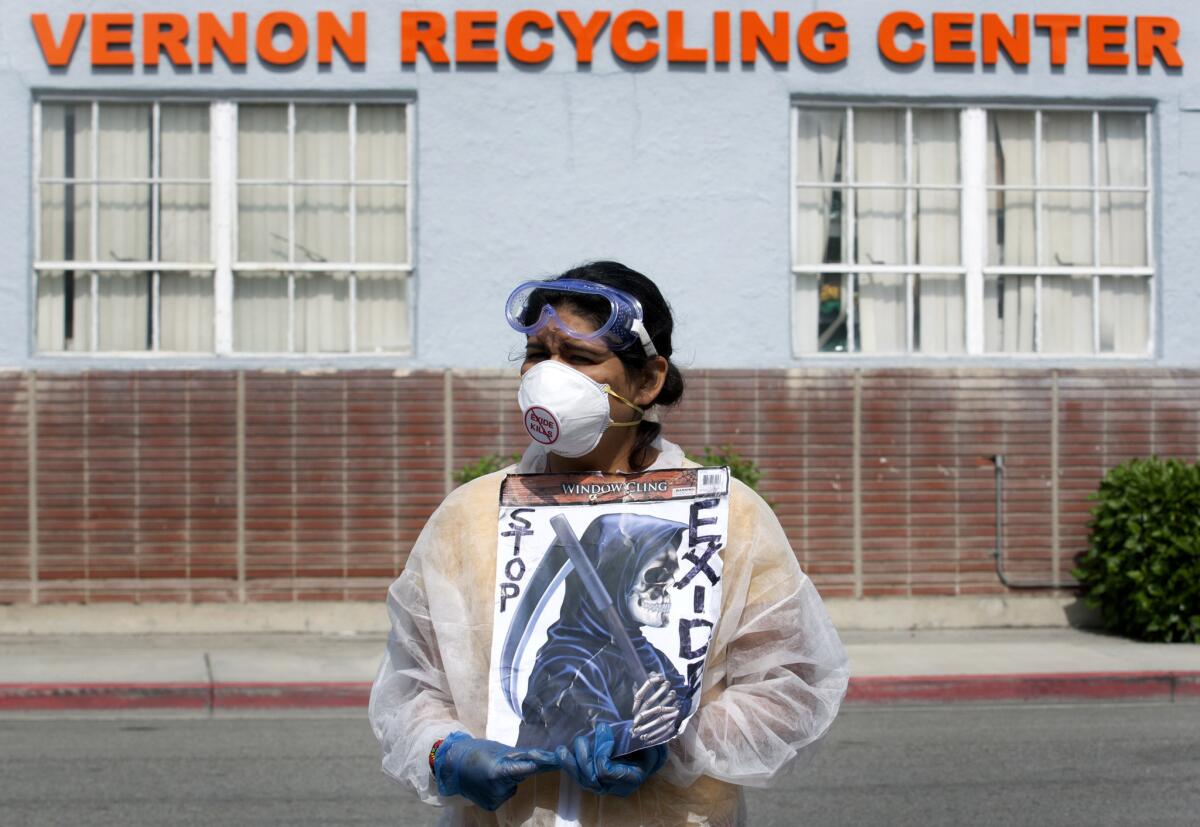Q&A: Exide closure a long-sought win for working-class neighborhood

- Share via
For residents in a large swath of southern Los Angeles County, living next to heavy industry has always been a contentious part of life.
Postwar development placed homes close to industrial facilities, which led to conflicts. Residents in the South Bay, for example, protested for years to improve safety regulations at oil refineries after a series of deadly explosions.
But perhaps the biggest clash has been over pollution, and the Exide battery recycling plant in Vernon was the focal point of a heated and long-running battle.
Residents who said it was an issue of environmental justice fought for decades to close the plant. This week, they got their wish.
The closure marks a major political victory for the working-class, predominantly Latino residents who live around the plant.
It's "a victory for the community," County Supervisor Hilda Solis said in a statement. "They fought hard to have their voices heard and kept steady pressure on Exide and government regulators."
Bell Mayor Nestor Valencia said, "The harm Exide inflicted upon the environment and the health of the surrounding residents and workers in the path of the plume is inexcusable and will continue harming us for years to come."
The plant's closure comes amid a greater focus on pollution in poor neighborhoods.
Last year, the California Environmental Protection Agency released a statewide list of census tracts most burdened by pollution, providing a first-of-its-kind ranking.
Many of the worst pollution pockets identified and mapped by state officials are in the San Joaquin Valley, Los Angeles County and the Inland Empire. Their residents are largely low-income Latinos who have had little power to force improvements in their communities.
Q: What is the history of the plant?
Like many industrial facilities, the Exide facility was there before major residential development. The facility has operated in Vernon since 1922 and has been operated by Exide since 2000.
Q: How did the community work to close the plant?
There have been complaints about pollution for years. But the community became galvanized most recently in 2013, when an air quality district report found the plant's arsenic emissions posed an increased cancer risk to more than 100,000 people in the area.
The revelation provoked outrage among community groups and elected officials, who have rallied to close the facility permanently.
In response, Los Angeles County tried to test lead levels in the blood of people living near Exide. But the tests didn't appear to draw enough participants to be of use in measuring the effects of the plant's air pollution.
A Los Angeles Times investigation in 2013 found the Department of Toxic Substances Control, which is supposed to use regulations, fines and the threat of legal action to protect Californians and the environment, often acted in a way that was ineffectual and glacially slow. The department's handling of Exide was cited in the investigation.
Q: What do we know about the closure of the plant?
Under the deal, Exide will acknowledge criminal conduct, including the illegal storage and transportation of hazardous waste but will avoid prosecution in exchange for shutting down, demolishing and cleaning its 15-acre battery recycling plant.
Over the course of decades of operation, the facility has polluted the soil beneath it with high levels of lead, arsenic, cadmium and other toxic metals, according to state environmental records. It also has fouled groundwater, released battery acid onto roads and contaminated homes and yards in surrounding communities with lead emissions.
Q: What areas were greatly affected?
There was soil testing by California toxic waste regulators in the area surrounding the plant as well as blood screenings for lead poisoning. The graphic below shows the areas affected. Enter an address to see whether it falls within the boundaries.
Sources: California Department of Toxic Substances Control, U.S. Census, Los Angeles County Department of Public Health
Q: Where did last year's state study find pollution problems?
Some of the worst-scoring neighborhoods sit next to busy ports, railyards and freeways in places such as Boyle Heights, Long Beach, San Bernardino and San Jose, where residents are exposed to higher levels of air pollution from vehicle exhaust.
Topping the list is a tract in Fresno crisscrossed by freeways, where more than 3,000 people live with the some of the state's highest levels of toxic air releases and asthma rates.
A pocket of homes west of Ontario International Airport is high on the list because it has some of the state's worst smog, diesel soot and a high number of cleanup sites and hazardous waste facilities.
Also highly affected by pollution, the analysis showed, are farming communities in the Central Valley and around Salinas and Oxnard, where residents near agricultural fields contend with contaminated drinking water, poor air quality and heavy pesticide use.
Source: Los Angeles Times reporting
Sign up for Essential California
The most important California stories and recommendations in your inbox every morning.
You may occasionally receive promotional content from the Los Angeles Times.








